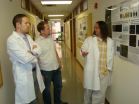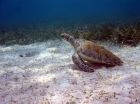(Press-News.org) When a proton – the bare nucleus of a hydrogen atom – transfers from one molecule to another, or moves within a molecule, the result is a hydrogen bond, in which the proton and another atom like nitrogen or oxygen share electrons. Conventional wisdom has it that proton transfers can only happen using hydrogen bonds as conduits, "proton wires" of hydrogen-bonded networks that can connect and reconnect to alter molecular properties.
Hydrogen bonds are found everywhere in chemistry and biology and are critical in DNA and RNA, where they bond the base pairs that encode genes and map protein structures. Recently a team of researchers using the Advanced Light Source (ALS) at the U.S. Department of Energy's Lawrence Berkeley National Laboratory (Berkeley Lab) discovered to their surprise that in special cases protons can find ways to transfer even when hydrogen bonds are blocked. The team's results appear in Nature Chemistry.
Stacking the odd molecules
A group led by Musahid Ahmed, a senior scientists in Berkeley Lab's Chemical Sciences Division (CSD), has long collaborated with a theoretical research group at the University of Southern California (USC) headed by Anna Krylov. In recent work to understand how bases are bonded in staircase-like molecules like DNA and RNA, Krylov's group made computer models of paired, ring-shaped uracil molecules, and investigated what might happen to these doubled forms (dimers) when they were subjected to ionization – the removal of one or more electrons with resulting net positive charge.
Uracil is one of the four nucleobases of RNA, whose structure is similar to DNA except that, while both use the bases adenine, cytosine, and guanine, in DNA the fourth base is thymine and in RNA it's uracil. The USC group used a uracil dimer labeled 1,3-dimethyluracil – "a strange creature that doesn't necessarily exist in nature," says CSD's Amir Golan, who led the Berkeley Lab team at the ALS. The purpose of this strange creature, Golan says, is to block hydrogen bonding of the two identical monomers of the uracil dimer by attaching a methyl group to each, "because methyl groups are poison to hydrogen bonds."
The uracils could still bond in the vertical direction by means of pi bonds, which are perpendicular to the usual plane of bonding among the flat rings of uracil and other nucleobases. "Pi stacking" is important in the configuration of DNA and RNA, in protein folding, and in other chemical structures as well, and pi stacking was what interested the USC researchers. They brought their theoretical calculations to Berkeley Lab for experimental testing at the ALS's Chemical Dynamics beamline 9.0.2.
To examine how the molecules were bonded, Golan and his colleagues first created a gaseous molecular beam of real methylated uracil monomers and dimers, then ionized them with a beam of energetic ultraviolet light from the ALS synchrotron. The resulting species were weighed in a mass spectrometer to see how the uracil had responded to the extra boost of energy.
"Uracils could be joined by hydrogen bonds or by pi bonds, but these uracils had been methylated to block hydrogen bonds. So what we expected to see when we ionized them was that if they were bonded, they would have to be stacked on top of each other," Golan says. Instead of holding together by pi bonds, however, when ionized some uracil dimers had fallen apart into monomers that carried an extra proton.
Where the protons come from
"What we did not expect to see was proton transfer," Golan says. "Surprising as this was, we needed to find where the protons were coming from. The methyl groups consist of a single carbon atom and three hydrogen atoms, but methylated uracil has other hydrogens too. Still, the methyl groups were the natural suspects."
To test this hypothesis, the researchers invited colleagues from Berkeley Lab's Molecular Foundry to join the collaboration. They created methyl groups in which the hydrogen atoms – which like most hydrogen had single protons as their nuclei – were replaced by deuterium atoms, "heavy hydrogen" atoms with nuclei consisting of a proton and a neutron of virtually the same mass.
The molecular beam experiment was repeated at the ALS, and once again some of the methylated uracil dimers fell apart into monomers upon ionization. This time, however, the tell-tale monomers were not simply protonated, they were deuterated.
Says Golan, "By looking at the mass of the fragments we could see that instead of uracil plus one" – the mass of a single proton – "they were uracil plus two" – a proton and neutron, or deuteron. "This proved that indeed the transferred protons came from the methyl groups."
The experiment showed that proton transfer in this case followed a very different route from the usual process of hydrogen bonding. Here the transfer involved not just an attraction between molecular arrangements that were slightly positively charged and others that were slightly negatively charged, as in a hydrogen bond. Instead it required significant rearrangements of the two uracil dimer fragments, to allow protons of hydrogen atoms in the methyl group on one monomer to move closer to an oxygen atom in the other. Theoretical calculations of the new pathway were led by USC's Krylov and Ksenia Bravaya.
The moral of the story, says Golan, is that methyl groups do not always kill proton transfer. "Granted, this was a model system – what we did was ionize the uracil systems in the gas phase instead of in solution, as would be the case in a living organism," he says. "Nevertheless, we showed that proton transfer is possible without hydrogen-bonding networks. Which means there could be unsuspected pathways for proton transfer in RNA and DNA and other biological processes – especially those that involve pi-stacking – as well as in environmental chemistry and in purely chemical processes like catalysis."
The next step: a range of new experiments to directly map proton transfer rates and gain structural insight into the transfer mechanism, with the goal of visualizing these unexpected new pathways for proton transfer.
INFORMATION:
"Ionization of dimethyluracil dimers leads to facile proton transfer in the absence of H-bonds," by Amir Golan, Ksenia B. Bravaya, Romas Kudirka, Oleg Kostko, Stephen R. Leone, Anna I. Krylov, and Musahid Ahmed, is published by Nature Chemistry and appears in advance online publication at http://www.nature.com/nchem/index.html. Golan, Kostko, Leone, and Ahmed are with Berkeley Lab's Chemical Sciences Division, and Golan and Leone are also with the Departments of Chemistry and Physics at the University of California at Berkeley. Bravaya and Krylov are with the University of Southern California. Kudirka is with Berkeley Lab's Materials Sciences Division. This work was supported principally by the U.S. Department of Energy's Office of Science, and by the Department of Defense and the National Science Foundation.
For more about the Chemical Dynamics Beamline at the ALS, visit www.chemicaldynamics.lbl.gov.
For more about Anna Krylov's research, visit iopenshell.usc.edu/krylovgroup/.
The Advanced Light Source is a third-generation synchrotron light source producing light in the x-ray region of the spectrum that is a billion times brighter than the sun. A DOE national user facility, the ALS attracts scientists from around the world and supports its users in doing outstanding science in a safe environment. For more information visit www-als.lbl.gov/.
The Molecular Foundry is one of five DOE Nanoscale Science Research Centers (NSRCs), national user facilities for interdisciplinary research at the nanoscale, supported by the DOE Office of Science. Together the NSRCs comprise a suite of complementary facilities that provide researchers with state-of-the-art capabilities to fabricate, process, characterize, and model nanoscale materials, and constitute the largest infrastructure investment of the National Nanotechnology Initiative. For more information about the DOE NSRCs, please visit science.energy.gov.
DOE's Office of Science is the single largest supporter of basic research in the physical sciences in the United States, and is working to address some of the most pressing challenges of our time. For more information, please visit the Office of Science website at science.energy.gov/.
Lawrence Berkeley National Laboratory addresses the world's most urgent scientific challenges by advancing sustainable energy, protecting human health, creating new materials, and revealing the origin and fate of the universe. Founded in 1931, Berkeley Lab's scientific expertise has been recognized with 13 Nobel prizes. The University of California manages Berkeley Lab for the U.S. Department of Energy's Office of Science. For more, visit www.lbl.gov.
A surprising new kind of proton transfer
Berkeley Lab scientists and their colleagues have discovered an unsuspected way that protons can move among molecules -- revealing new opportunities for research in biology, environmental science, and green chemistry
2012-03-19
ELSE PRESS RELEASES FROM THIS DATE:
Genetic variation in East Asians found to explain resistance to cancer drugs
2012-03-19
DURHAM, N.C., AND SINGAPORE – A multi-national research team led by scientists at Duke-NUS Graduate Medical School has identified the reason why some patients fail to respond to some of the most successful cancer drugs.
Tyrosine kinase inhibitor drugs (TKIs) work effectively in most patients to fight certain blood cell cancers, such as chronic myelogenous leukemia (CML), and non-small-cell lung cancers (NSCLC) with mutations in the EGFR gene.
These precisely targeted drugs shut down molecular pathways that keep these cancers flourishing and include TKIs for treating ...
Exotic materials will change optics, Duke researchers say
2012-03-19
DURHAM, N.C. -- Duke University engineers believe that continued advances in creating ever-more exotic and sophisticated man-made materials will greatly improve their ability to control light at will.
The burgeoning use of metamaterials in the field of optics does not rely on the limited set of materials found in nature, but rather man-made constructs that can be designed to control light's many properties. This control is gained by use of metamaterials, which are not so much single substances but entire man-made structures that can be engineered to exhibit properties ...
Special Safety Issues Facing Older Drivers and Pedestrians
2012-03-19
As we most of us already know, aging usually means we'll experience more problems with our hearing, vision and motor skills. In order to grow older safely, we must first recognize our vulnerabilities. Once we do this, we can adapt our behavior in order to create a safer environment for ourselves and everyone else.
The following statistics shed light on the special safety issues facing seniors both behind the wheel and when walking around as pedestrians.
Safety Issues for Senior Drivers/Pedestrians
(Note: In 2009, approximately 40 million Americans were age 65 and ...
Bone marrow transplant arrests symptoms in model of Rett syndrome
2012-03-19
A paper published online today in Nature describes the results of using bone marrow transplant (BMT) to replace faulty immune system cells in models of Rett Syndrome. The procedure arrested many severe symptoms of the childhood disorder, including abnormal breathing and movement, and significantly extended the lifespan of Rett mouse models. Exploring the function of microglia deficient in methyl-CpG binding protein 2 (Mecp2), the protein encoded by the "Rett gene," principal investigator Jonathan Kipnis, Ph.D. and his team at the University of Virginia School of Medicine ...
The Viking journey of mice and men
2012-03-19
House mice (Mus musculus) happily live wherever there are humans. When populations of humans migrate the mice often travel with them. New research published in BioMed Central's open access journal BMC Evolutionary Biology has used evolutionary techniques on modern day and ancestral mouse mitochondrial DNA to show that the timeline of mouse colonization matches that of Viking invasion.
During the Viking age (late 8th to mid 10th century) Vikings from Norway established colonies across Scotland, the Scottish islands, Ireland, and Isle of Man. They also explored the north ...
The Japanese traditional therapy, honokiol, blocks key protein in inflammatory brain damage
2012-03-19
Microglia are the first line defence of the brain and are constantly looking for infections to fight off. Overactive microglia can cause uncontrolled inflammation within the brain, which can in turn lead to neuronal damage. New research published in BioMed Central's open access journal Journal of Neuroinflammation shows that, honokiol (HNK) is able to down-regulate the production of pro-inflammatory cytokines and inflammatory enzymes in activated microglia via Klf4, a protein known to regulate DNA.
Scientists from the National Brain Research Centre, Manesar, India, used ...
Hazy shades of life on early Earth
2012-03-19
A 'see-sawing' atmosphere over 2.5 billion years ago preceded the oxygenation of our planet and the development of complex life on Earth, a new study has shown.
Research, led by experts at Newcastle University, UK, and published today in the journal Nature Geoscience, reveals that the Earth's early atmosphere periodically flipped from a hydrocarbon-free state into a hydrocarbon-rich state similar to that of Saturn's moon, Titan.
This switch between "organic haze" and a "haze-free" environment was the result of intense microbial activity and would have had a profound effect ...
Marine Protected Areas are keeping turtles safe
2012-03-19
Marine Protected Areas (MPAs) are providing sea turtles with an ideal habitat for foraging and may be keeping them safe from the threats of fishing. A study by an international team of scientists led by the University of Exeter, published today (Thursday 15 March), shows that 35 per cent of the world's green turtles are found within MPAs. This is much higher that would be expected as only a small proportion of shallow oceans are designated as MPAs.
MPAs are areas of ocean in which marine activities such as fishing are restricted. Regulated by governments and NGOs, in ...
Personal Electronics Linked to Rise in Pedestrian Accidents
2012-03-19
A study recently released by the University of Maryland found that pedestrian fatalities are on the rise due to distractions from headphone use. The majority of incidents were found among men younger than 30 who lived in urban areas.
The issue is that headphones playing music directly in pedestrians' ears may hinder their ability to hear oncoming car horns, revving engines, beeping crosswalk lights and even blaring train whistles. The study was conceived after a train killed a teenager wearing headphones while crossing railroad tracks. The teenager's music had drowned ...
Looking at quantum gravity in a mirror
2012-03-19
Einstein's theory of gravity and quantum physics are expected to merge at the Planck-scale of extremely high energies and on very short distances. At this scale, new phenomena could arise. However, the Planck-scale is so remote from current experimental capabilities that tests of quantum gravity are widely believed to be nearly impossible. Now an international collaboration between the groups of Caslav Brukner and Markus Aspelmeyer at the University of Vienna and Myungshik Kim at Imperial College London has proposed a new quantum experiment using Planck-mass mirrors. Such ...
LAST 30 PRESS RELEASES:
Making lighter work of calculating fluid and heat flow
Normalizing blood sugar can halve heart attack risk
Lowering blood sugar cuts heart attack risk in people with prediabetes
Study links genetic variants to risk of blinding eye disease in premature infants
Non-opioid ‘pain sponge’ therapy halts cartilage degeneration and relieves chronic pain
AI can pick up cultural values by mimicking how kids learn
China’s ecological redlines offer fast track to 30 x 30 global conservation goal
Invisible indoor threats: emerging household contaminants and their growing risks to human health
Adding antibody treatment to chemo boosts outcomes for children with rare cancer
Germline pathogenic variants among women without a history of breast cancer
Tanning beds triple melanoma risk, potentially causing broad DNA damage
Unique bond identified as key to viral infection speed
Indoor tanning makes youthful skin much older on a genetic level
Mouse model sheds new light on the causes and potential solutions to human GI problems linked to muscular dystrophy
The Journal of Nuclear Medicine ahead-of-print tip sheet: December 12, 2025
Smarter tools for peering into the microscopic world
Applications open for funding to conduct research in the Kinsey Institute archives
Global measure underestimates the severity of food insecurity
Child survivors of critical illness are missing out on timely follow up care
Risk-based vs annual breast cancer screening / the WISDOM randomized clinical trial
University of Toronto launches Electric Vehicle Innovation Ontario to accelerate advanced EV technologies and build Canada’s innovation advantage
Early relapse predicts poor outcomes in aggressive blood cancer
American College of Lifestyle Medicine applauds two CMS models aligned with lifestyle medicine practice and reimbursement
Clinical trial finds cannabis use not a barrier to quitting nicotine vaping
Supplemental nutrition assistance program policies and food insecurity
Switching immune cells to “night mode” could limit damage after a heart attack, study suggests
URI-based Global RIghts Project report spotlights continued troubling trends in worldwide inhumane treatment
Neutrophils are less aggressive at night, explaining why nighttime heart attacks cause less damage than daytime events
Menopausal hormone therapy may not pose breast cancer risk for women with BRCA mutations
Mobile health tool may improve quality of life for adolescent and young adult breast cancer survivors
[Press-News.org] A surprising new kind of proton transferBerkeley Lab scientists and their colleagues have discovered an unsuspected way that protons can move among molecules -- revealing new opportunities for research in biology, environmental science, and green chemistry




